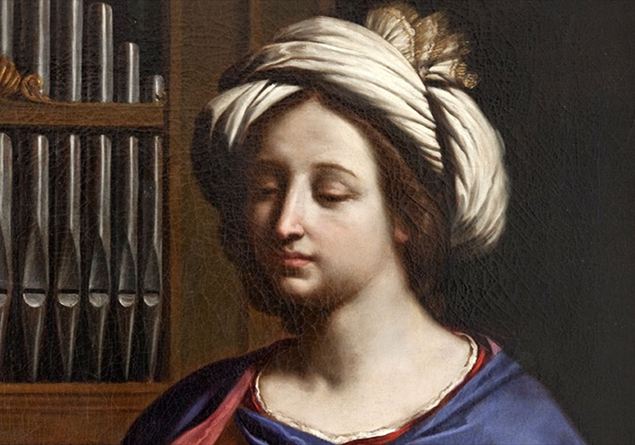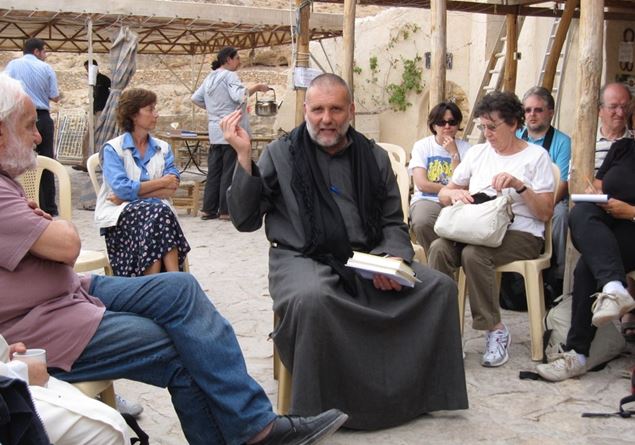
She is the patron saint of music, musicians and singers. Saint Cecilia virgin and martyr has inspired more than one artistic masterpiece, including the’Ecstasy of Saint Cecilia by Raphael, now in Bologna (a copy of which, made by Guido Reni, is found in the church of San Luigi dei Francesi in Rome, the Santa Cecilia by Rubens (in Berlin), by Domenichino (in Paris), by Artemisia Gentileschi. In literature, Cecilia was especially celebrated in Canterbury Tales by Geoffrey Chaucer, in a’ode by John Dryden then set to music by Handel in 1736, and later by Hubert Parry (1889). Other musical works dedicated to Cecilia include l’Hymn to Saint Cecilia by Benjamin Britten, a Hymn for Saint Cecilia by Herbert Howells, the note Missa Sanctae Ceciliae by Joseph Haydn, a mass by Alessandro Scarlatti, the Solemn Masses of Sainte Cécile by Charles Gounod, Hail, bright Cecilia! by Henry Purcell el’Sacred action in three episodes and four paintings by Licinio Refice (with a libretto by Emidio Mucci), Cecilia (1934), Cantata a Santa Cecilia (1998) by Frederik Magle, and Cecilia, virgin Roman cantata by Arvo Pärt.
Raphael, Ecstasy of Saint Cecilia
An ancient cult
The cult of Santa Cecilia is very ancient. There are two established facts: the basilica “title” of Cecilia is very ancient, certainly prior to’year 313, i.e. all’age of Constantine; the saint’s feast was already celebrated in her basilica in Trastevere, in’year 545. It also seems that Cecilia was buried in the Catacombs of San Callisto, in a place d’honor, next to the so-called «Crypt of the Popes», later transferred by Pasquale I to the crypt of the Trastevere basilica. The famous «Passio», a more literary than historical text, attributes to Cecilia a series of dramatic adventures, ending with the most cruel tortures and concluding with the cutting off of the head.
the biography
The Roman noblewoman, benefactor of the Popes and founder of one of the first churches in Rome, lived between the 2nd and 3rd centuries. It was registered in the canon of the Mass at the beginning of the 6th century, the century in which its cult arose. In the 3rd century Pope Callistus, a man of action and excellent administrator, had his predecessor Zeferinus buried next to the funeral hall of the Caecilii family. He later opened, next to the martyr, the “Crypt of the Popes”, in which all the other pontiffs of that same century were deposed. Cecilia married the noble Valerian. In her Passio it is said that on her wedding day the saint sang in her heart: “keep, oh Lord, my heart and my body immaculate, so that I do not remain confused”. From this detail she was called the patroness of musicians. Having confided her vow of chastity to her husband, he converted to Christianity and received Baptism from Pope Urban I on their wedding night. Cecilia had a particular gift: she was able to be convincing and converting. The Roman authorities captured Saint Valerian, who was tortured and beheaded; for Cecilia it was ordered to be burned, but, after a day and a night, the fire did not bother her; it was therefore decided to behead her: she was hit three times, but she did not die immediately and agonized for three days: many Christians that she had converted went to dip linens in her blood, while Cecilia did not desist from strengthening them in the Faith. When the martyr died, Pope Urban I, her spiritual guide, with his deacons, took the body at night and buried it with the other popes and made Cecilia’s house a church.
“Santa Cecilia” (1895) by John William Waterhouse
Because it is celebrated on November 22nd
The Liber pontificalis narrates that in the year 545, during the Christian persecutions, the imperial secretary Antimos went to arrest Pope Vigilius and found him in the church of Santa Cecilia, ten days before the calends of December, i.e. November 22nd, considered dies natalis of the holy. However, other historical sources (such as the 5th century Hieronimian Martyrology) believe that this is not the date of his death or burial, but of the dedication of his church.
on the wedding day
Cecilia married the noble Valerian. In her Passio it is said that the wedding day was enlivened by music and songs and that the Saint sang in her heart: «O Lord, keep my heart and my body immaculate, so that I do not remain confused». From this detail she was called the patroness of musicians. Having confided her vow of chastity to her husband, he converted to Christianity and received Baptism from Pope Urban I on their wedding night. Cecilia had a particular gift: she was able to be convincing and converting. The Roman authorities captured Saint Valerian, who was tortured and beheaded; for Cecilia it was ordered to be burned, but, after a day and a night, the fire did not bother her; it was therefore decided to behead her: she was hit three times, but she did not die immediately and agonized for three days: many Christians that she had converted went to dip linens in her blood, while Cecilia did not desist from strengthening them in the Faith. When the martyr died, Pope Urban I, her spiritual guide, with his deacons, took the body at night and buried it with the other popes and made Cecilia’s house a church.
The Cecilian movement for liturgical music
In the 19th century, the so-called Caecilian Movement arose, widespread in Italy, France and Germany. It was joined by musicians, liturgists and scholars who wanted to restore honor to liturgical music by removing it from the influence of melodrama and popular music. The movement had the great merit of re-presenting Gregorian chant and the Renaissance polyphony of Catholic liturgical celebrations in churches. Thus the various Scholae cantorum were born in almost all the parishes and the various Diocesan Institutes of Sacred Music (IDMS), which were to train the teachers of the Scholae themselves. The Tortonese and priest Lorenzo Perosi, who found a paternal patron in Saint Pius On November 22, 1903, the day of Saint Cecilia, the Pontiff issued the Motu Proprio Inter Solicitudesconsidered the manifesto of the Movement and with which that pontiff gave a reformative turning point to sacred music d’West, purified it from the theatrical degenerations in vogue all over’era and restored centrality and splendor to Gregorian chant, polyphonic singing and the sound of’organ.







